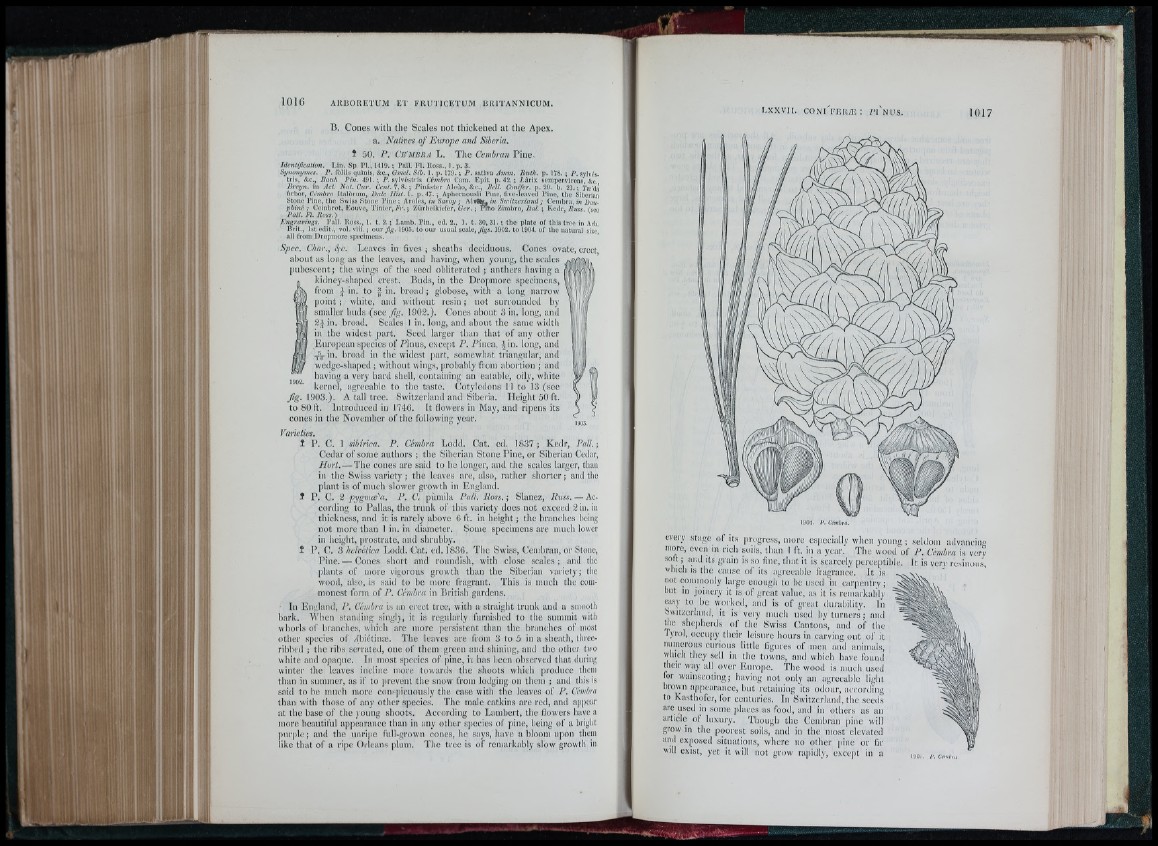
B. Cones with tlic Scales not thickened at thc Apex.
a. Nalivcs of Kvrojic and Siberia.
I 50. P. Ch'mhua L. Tho Ccmbran Pine,
Identification. Lin. Sj), Pl., H19. ; Pall. Pl. Rosa.. 1. p. 3.
Si/nonyines. P . fòli!« quiñis, &c., (ììnel. Sib. 1. p. 17!). ; P. satlvn Amm. liu th . p. 178. ; sylvéstris,
ite., Bnnh Pin. 491.; P. aylvóstria C(;inbr<> ('am. Kpit. p. 42, ; 7,Arix soitiporvlrons, ¿c,
Breyn. in Act. N/it. Cur. Cent. 7 ,S .; /'inlistcr Alci)»), &o., Bell. Conifer, p. 20. b. 21.; V’a-'d'à
firl)or, Cèmbro Ralíinim, Dale. U h i. 1. p. 47. ; Aplicniounli Pino, llvo-lonvcd Pino, the Siberian
Stone l ’ino, the Swiss Stone P ino; Areles, m ; A l f i ^ m Swiixcrlatid ; Ceinbra, m/J/ik.
phinf; ; Ceinbrot, JCouve, Tinier, Fr. : Ziirbolkiofor, Ír'í r . : ffiio Zlinbro, Ital. ; Koilr, Him. (seo
Pall. Fl. Boss.) '
Ensravings. Pall. Ros.s., 1. t. 2. ; Lamb. Pin,, cd. 2., 1. t. .10, 31. ; tho idnto of this tree in Arh
Rrlt., 1st edit., vol. vllt. ; our Jig. 1905. to our usual s c a le ,/¿ s . 1902. to 1904. oí the natural size!
all from Dropmore spoeiinons.
Spec. Char., 4c- Lcavcs in fives ; sheaths decidnous. Cones ovate, erect,
about as long as the leaves, and Iiaving, when young, the scalei
piibcsecnt; tlic wings of the seed obliterated ; aiithers iiaving t
kidncy-siiapcd crest. Buds, In the Dropmore specimens, '
from ¿ in. to -g- in. broad ; globose, with a long narro
point ; wliite, and without resin ; not siirroiinded by
smaller buds (see fig, 1902.). (fòncs about 3 in. long, and
in. broad. Scales I in. long, and about the .same width
in thc widest part. Seed larger tium that of any other
European species of 77mis, except 1 \ i ’iiiea, ^ in. king, and
-/^in. hroad iu the widest part, somewhat triangular, and
wedge-shaped ; without wings, prohahly from abortion ; and
having a very Iiard shell, containing an eatable, oily, wdiite
kernel, agreeable to the taste, (k)tylcdons I i to 13 (soc
1903.). A tall tree. Switzerland and Siberia, lleight 50 ft.
to 80 ft. Introduced in 1740. It iiowers in May, and ripens its
cones iu the November of tlic following year.
Varieties.
t V. C. 1 sibirica. P. Ccnibra Lodd. Cat. cd. 1837; Kedr, Pa//.;
(!edar of some autliors ; tlie Siberian Stone Bine, or Siberian Ccdiir,
Jfort. — Tlie eoncs arc said to he longer, and tho scales larger, tliiui
in tlic Sw'iss variety ; thc leaves are, also, ratlier shorter j ami the
plant is of nmch slower growth in England.
Í P. C. 2 pygmcc''a. P. C. pùmila Pall, lioss.; Slanez, lluss. — According
to Pallas, the trunk of this variety does not exceed 2 in. in
thickness, and it is rarely above 0 ft. in height ; tlic branelics being
not more than 1 in. in diameter. Some specimens are much lower
in liciglit, prostrate, and shrubby.
Í P. (k 3 hdvcliva Lodd. Cat. ed. 183(). Thc Swiss, Ceinhran, or Stone,
I’inc. — Cones short and roundish, witii close scales; and the
plants of more vigorous growth than the Siheriau variety; the
wood, also, is said to be moro fragrant. This is much the commonest
I'orm of 7? Cvmhra in British gardens.
In I ’.ngland, P. Cémbra is an ei'cet tree, with a straight trunk and a smooth
hark. \\'hen stamling .singly, it is regularly furnished to thc summit with
w'liorls of hranches, which are more persistent than thc lirunehes of most
other .species of //hielime. The leaves are from 3 lo 5 in a sheath, tlirce-
rihhed ; the ribs serrated, one of them green and shining, and the other two
wiiite and ojiaijnc. In mo.sC spi'cics of jiine, ii has heen oliscrved tliut diiriiig
winter the leaves incline more towards tho shoots which jiroduce llicm
than in smnmcr, as if to prevent the snow from lodging on them ; and tlii.s in
said to 1)0 imicli more consjiicuously tiie case with the leaves of P. Ccvihra
tlian with those of any other species. The mule catkin.s are red, and apiieiir
at the base of the young slioots. According to Lambert, the flowers have a
more beautiful appearance than in any other s)iecies of pine, lieing of a liriglit
purple; and the uiinpe lull-grown eoncs, he says, have a bloom upon tlicm
like that of a ripe Orleans plum. Tlie tree is of reniaikably slow grow'th in
1904. /*. (.V»i/ir«.
cvciy stiige C)l ] |S |ir«grcss, iiioro e.spucially wl.cii young ; seliloin iulvmiciim
moi'o, Gvo.i 111 rich soils, liiaii I ft. iu a year. The; wood of P. Cimhm is very
soil; aud Its gram is .so fine, lliat it is scarcely |)trcc|)tiblc. It is verv rcsiuous,
wlucli IS the cause of its agreeable fragrance. It is
not (:onimonly largo eiiongli to he used in carpentry;
hut in joinery it is of great value, as it is remarkably
easy to lie worked, and is of great durability. Iu
Swiizeriaiul, it i.s very mucii used hy turners ; ami
tlie sliephcrd.s of the Swiss Cantons, and of the
lyrol, occnjiy their leisure liours in carving out of it
niiinorous curious little figmos of men and animals,
which they sell iu the towns, and vvliicii have found
tiieir way all ()ver Europe. The wood is nuicli used
lor wain.scoting; iiaving not only an agreeable light
brown appearance, but retaining its odour, according
to Kastliofcr, (br centuries. In Switzerland, thc seeds
arc used in some places as food, and in otliors as an
»rticle of luxury. Though tlic Cemhran ¡)ine will
grow in tile poorest soils, and in the most elevated
ami exposed situations, where no otlier pine or fir
will exist, yet it will not grow rapidly, except in a 190:.. /•. Cemtmt